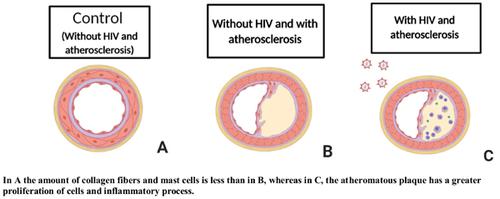Current HIV Research ( IF 1 ) Pub Date : 2021-02-28 , DOI: 10.2174/1570162x18999201029123356 Mariana Silva Oliveira 1 , Bianca Gonçalves da Silva Torquato 1 , Simone Yumi Tsuji 1 , Laura Sanches Aguiar 1 , Guilherme Ribeiro Juliano 1 , Luciano Alves Matias da Silveira 1 , Rosana Rosa Miranda Corrêa 1 , Lenaldo Branco Rocha 1 , Mara Lúcia da Fonseca Ferraz 1

|
Background: Chronic infection by HIV evolves with a vascular inflammatory action causing endothelial dysfunction. The action of the virus, as well as the side effects of antiretroviral drugs, contribute to the progression of cardiovascular diseases. The present study aimed to evaluate the percentage of collagen fibers and the density of mast cells, chymase and tryptase, in aortas of patients with and without HIV, and also patients with and without atherosclerosis.
Methods: Aortic fragments were obtained from autopsied patients aged 22-69 years and selected regardless of the cause of death or underlying disease. The samples were divided into four groups, (1) Group with HIV and with atherosclerosis; (2) Group with HIV and without atherosclerosis; (3) Group without HIV and with atherosclerosis; (4) Group without HIV and without atherosclerosis (Control). The percentage of collagen fibers was analyzed in the intima-media layer and the density of mast cells was analyzed in all aortic layers. Graphpad Prism 5.0® software was used for statistical analysis.
Results: There were more collagen fibers in HIV patients, with or without atherosclerosis. The group with HIV and atherosclerosis presented a higher density of chymase and tryptase mast cells. The correlation between collagen fibers and age was negative in the non-HIV group and with atherosclerosis.
Conclusion: The inflammatory process resulting from HIV infection may be relevant in the alteration of aortic collagen fibers and in triggering or accelerating atherosclerosis. The study is important because HIV patients have increased risks for the development of cardiovascular diseases, and follow-up is necessary to prevent such diseases.
中文翻译:

动脉粥样硬化和艾滋病毒尸检患者的形态学和组织病理学研究
背景:HIV 慢性感染随着血管炎症作用的发展而演变,导致内皮功能障碍。病毒的作用以及抗逆转录病毒药物的副作用会导致心血管疾病的进展。本研究旨在评估感染和未感染 HIV 以及患有和未患有动脉粥样硬化的患者的主动脉中胶原纤维的百分比和肥大细胞、糜蛋白酶和类胰蛋白酶的密度。
方法:从 22-69 岁的尸检患者中获取主动脉碎片,无论死亡原因或潜在疾病如何选择。样本分为四组,(1)HIV和动脉粥样硬化组;(2) HIV 感染组,无动脉粥样硬化;(3) 无 HIV 且有动脉粥样硬化的人群;(4)没有HIV和没有动脉粥样硬化的组(对照)。分析了内膜中层中胶原纤维的百分比,并分析了所有主动脉层中的肥大细胞密度。Graphpad Prism 5.0 ®软件用于统计分析。
结果:无论有无动脉粥样硬化,HIV患者的胶原纤维均较多。HIV 和动脉粥样硬化组表现出更高密度的糜蛋白酶和类胰蛋白酶肥大细胞。胶原纤维与年龄之间的相关性在非 HIV 组和动脉粥样硬化中呈负相关。
结论:HIV 感染引起的炎症过程可能与主动脉胶原纤维的改变以及引发或加速动脉粥样硬化有关。这项研究很重要,因为 HIV 患者患心血管疾病的风险增加,并且有必要进行随访以预防此类疾病。


























 京公网安备 11010802027423号
京公网安备 11010802027423号